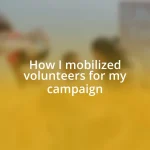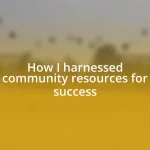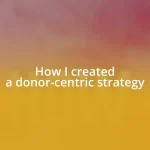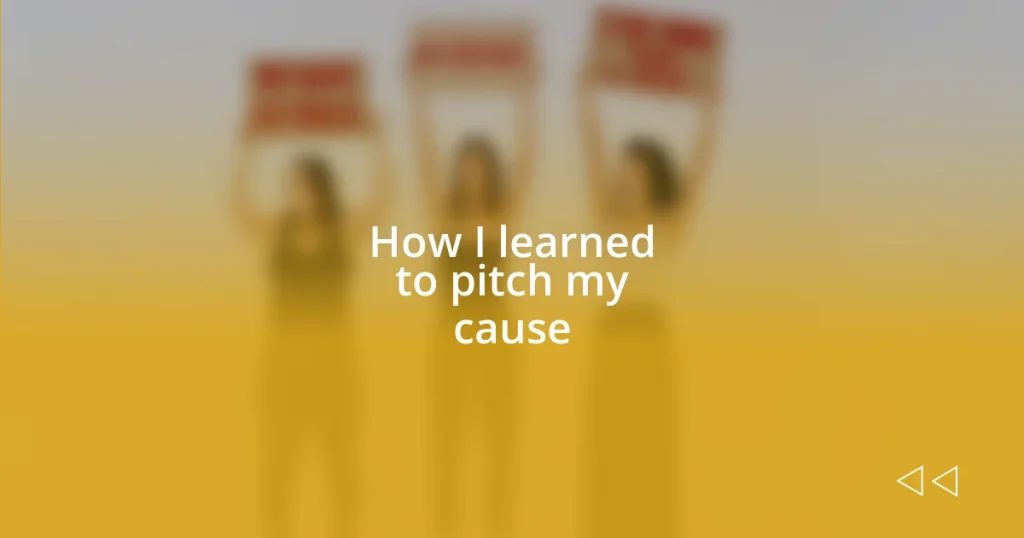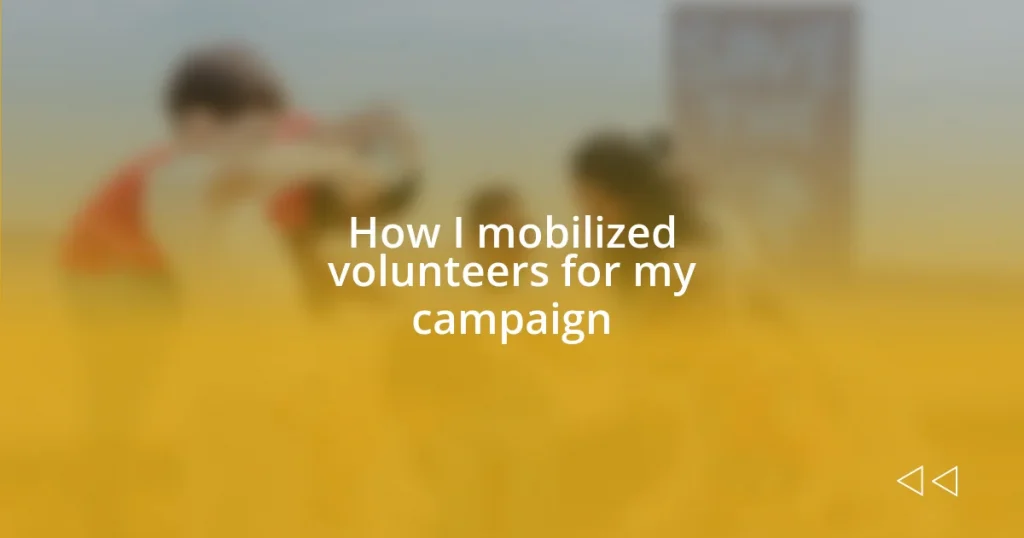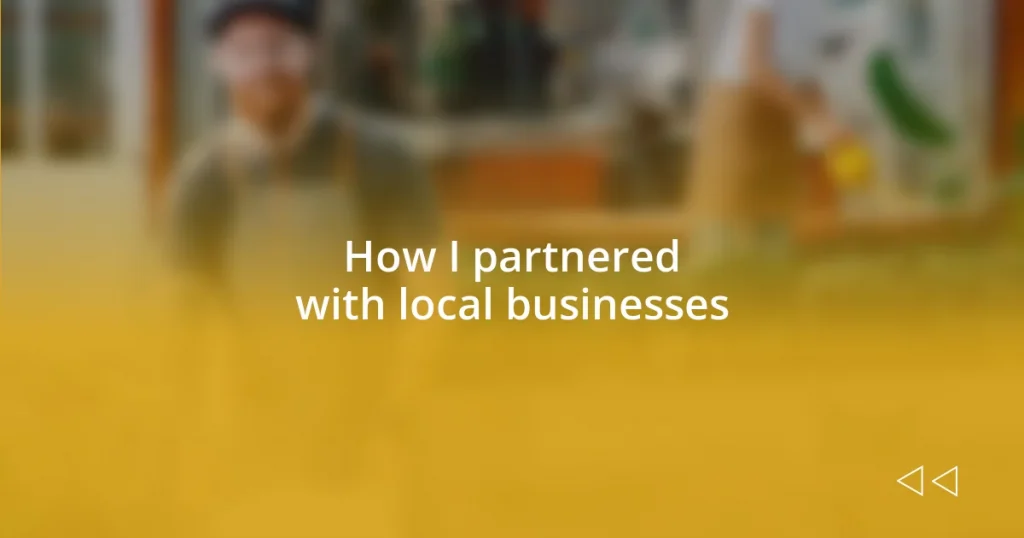Key takeaways:
- Effective pitching combines storytelling with personal connection, engaging emotions rather than just presenting facts.
- Practicing delivery and adapting to audience feedback enhances confidence and connection during a pitch.
- Following up after a pitch reinforces commitment, fosters relationships, and can lead to new opportunities and collaborations.
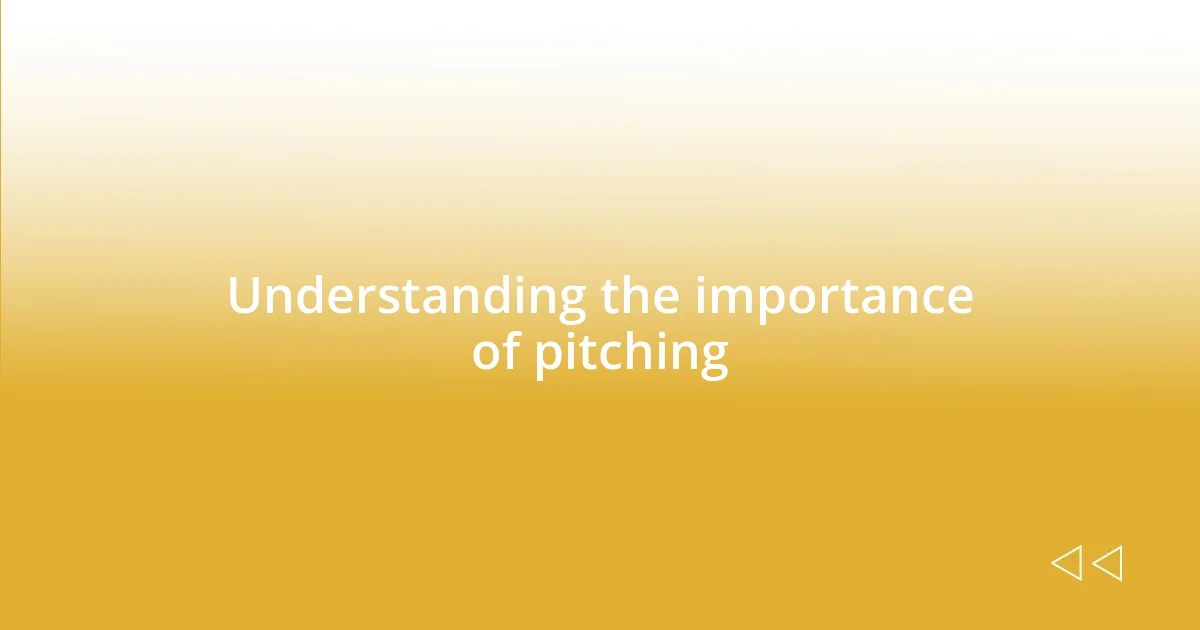
Understanding the importance of pitching
Pitching is like crafting a story; it’s your chance to ignite passion in others about your cause. I remember one time I stood before a small group, nervously clutching my notes, when I realized that if I didn’t express my genuine belief in what I was pitching, no one else would connect with it. How do you expect people to rally behind an idea if you aren’t fully invested in sharing it?
When I first learned to pitch, I approached it as a mere formality, but I quickly discovered its real power. A great pitch isn’t just about presenting facts; it’s about weaving a narrative that resonates with emotions. Think about it: when was the last time you felt moved by dry statistics compared to an authentic story?
Ultimately, pitching can open doors you didn’t even know existed. I recall the thrill of watching someone’s eyes light up as I shared my vision, and in that moment, I understood that pitching is not just a skill—it’s an art. By engaging others this way, you’re also inviting them to be part of something larger than themselves, and that’s incredibly motivating.

Identifying your cause effectively
Identifying your cause is the first crucial step toward effective pitching. I remember sitting down one afternoon, coffee in hand, and reflecting on what pushed me to advocate for certain issues. It struck me that my cause wasn’t merely a project; it stemmed from deeply held values and personal experiences. Recognizing what truly matters to you creates an authentic foundation for your pitch, making it resonate more with others.
To identify your cause effectively, consider these key aspects:
– Personal Connection: Reflect on experiences that have impacted you or sparked your interest.
– Community Impact: Think about issues that affect your community and how your passion can create change.
– Research: Dive into statistics or stories that illustrate the need for your cause.
– Clarity of Purpose: Define what success looks like for your cause.
– Alignment with Values: Ensure that your cause aligns with your core beliefs and goals.
By engaging with these elements, you not only clarify your purpose but also prepare yourself to convey that passion to others in a way that’s meaningful and impactful.
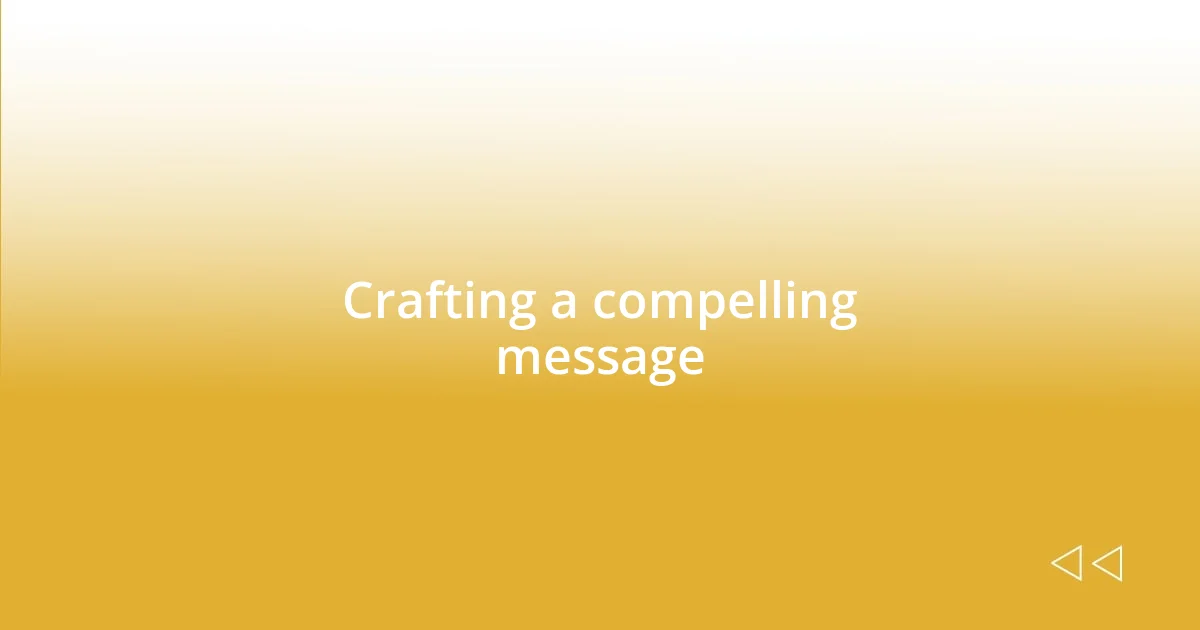
Crafting a compelling message
Crafting a compelling message requires you to distill your passion into clear, relatable concepts. I often find that when I simplify my message, it transforms into something more powerful. For instance, during my early pitching days, I wrapped my cause in jargon and complicated explanations. However, I soon realized that using simple, vivid language helped my audience connect emotionally. It’s almost like turning a complicated recipe into a delicious home-cooked meal; the simpler it is, the more people can appreciate and savor it.
Another aspect I learned is the importance of storytelling as a tool in messaging. I recall one particular pitch when I shared a personal story about a friend who faced challenges related to my cause. The way their struggles wove through my narrative engaged the audience, turning nods of understanding into heartfelt discussions afterward. That experience showed me that crafting a narrative that includes personal anecdotes not only captures attention but also invites empathy. People remember stories far longer than they remember statistics.
Lastly, focusing on the “why” of your cause is crucial to resonate with others. I’ve often asked myself: What made me care so deeply about my cause? When I distilled that passion into a clear message, it sparked conversations with others who felt the same. I encourage you to think deeply about your own connection to the cause—articulating that emotional core can be the transformative element that invites others to join your mission.
| Aspect | Importance |
|---|---|
| Simplicity | Allows for easier connection and understanding. |
| Storytelling | Engages emotions and creates lasting memories. |
| Articulating the “why” | Invites others to feel inspired and involved. |
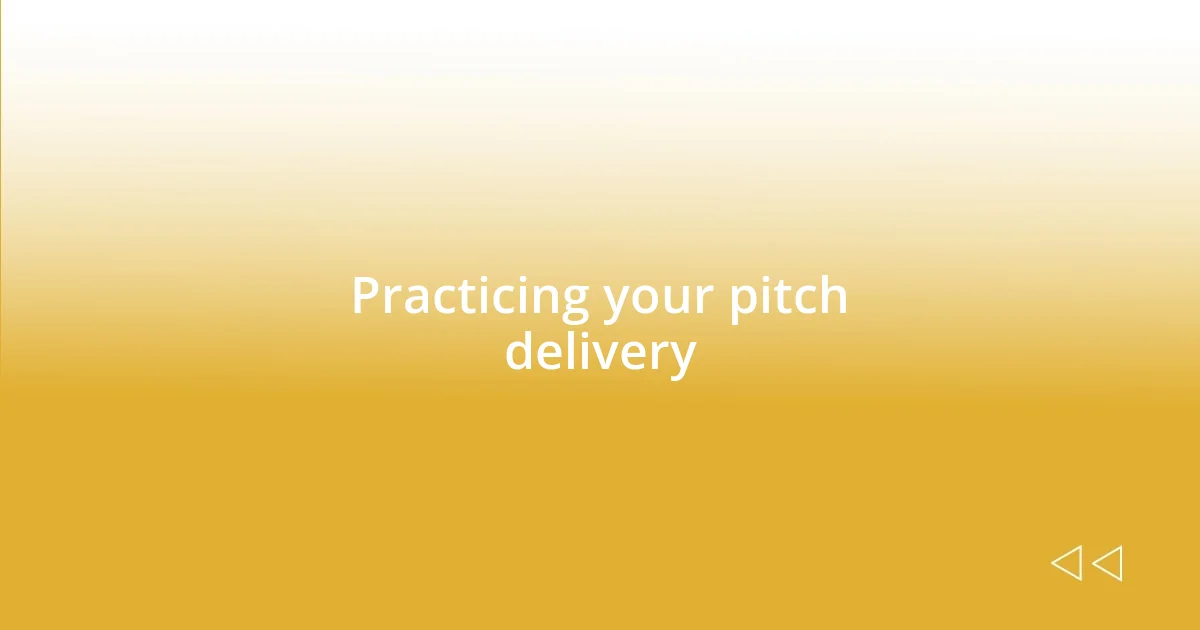
Practicing your pitch delivery
Practicing your delivery can transform a good pitch into a great one. I vividly remember the first time I stood in front of a small group to present my ideas. My heart raced, and I stumbled over my words. It dawned on me that the only way to gain confidence was through repetition. I began practicing in front of friends, seeking their feedback to refine my delivery. Each session was a step forward, and I noticed how important body language and pacing became once I was comfortable.
Recording myself was a game-changer. I captured my pitches and played them back, cringing at certain parts while also noticing moments of clarity and strength. This self-analysis not only improved my verbal skills but also highlighted areas where I could infuse more passion. I often ask myself, “How can I make this moment resonate?” Watching my delivery on tape helped me uncover the nuances that make a pitch truly engaging, such as eye contact and emphasis on key points.
I also found that practicing in varied environments was beneficial. When I pitched in front of a mirror, it felt different from presenting to an audience or even in a casual setting with friends. Each scenario helped me adapt my style. This made me realize an important truth: pitching isn’t just about the content; it’s also about how you connect with your audience. With each iteration, I learned to read the room, adjust my tone, and convey authenticity. Have you tried pitching in different settings? You might be surprised at how much your delivery can evolve!
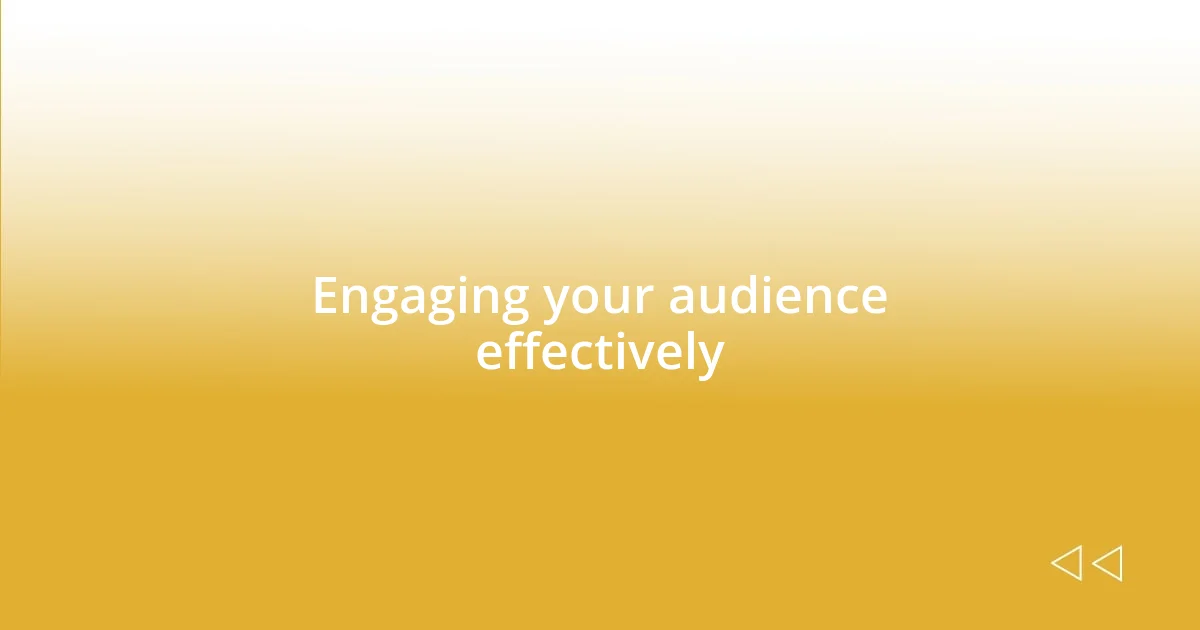
Engaging your audience effectively
Engaging your audience effectively hinges on understanding their needs and interests. I remember one occasion when I tailored my pitch to directly address a specific concern of the audience, and it worked wonders. By asking questions like, “What would make your life easier?” and weaving their responses into my narrative, I created a space where participants felt involved and valued. This shift in focus not only sparked lively discussions but also fostered a connection that encouraged empathy and support for my cause.
Active listening also plays a pivotal role. I’ve often witnessed how much insight I gain when I genuinely pay attention to the reactions of my audience. In one memorable pitch, I noticed a few skeptical faces. Instead of pushing through my script, I invited them to share their thoughts. This not only recalibrated my approach but turned potential resistance into engagement. It’s a reminder that inviting dialogue can transform monologues into meaningful conversations, boosting the overall impact of the presentation.
I’ve also learned that using visual aids can enhance engagement. One time, I utilized a simple infographic that illustrated my cause’s impact. The audience lit up as they followed the visuals—it was like a lightbulb moment for many. How often do we find ourselves captivated by a well-designed image? Visuals can simplify complex ideas, making your message not just seen but felt. Consider whether your presentations could benefit from a little visual storytelling too.
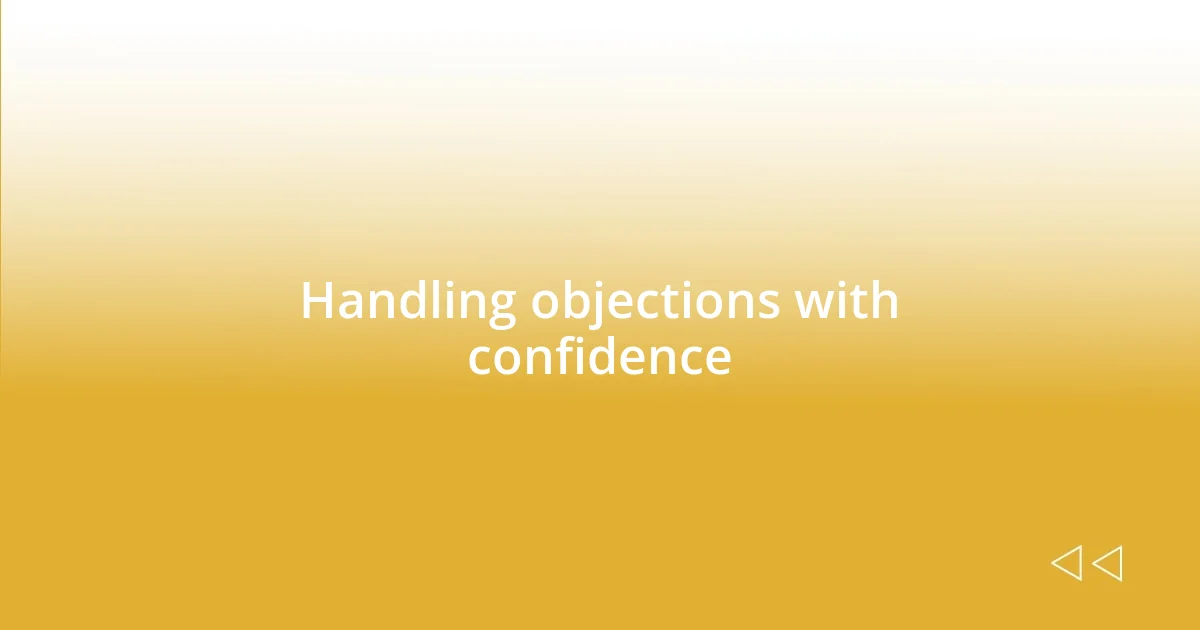
Handling objections with confidence
Handling objections confidently boils down to preparation and mindset. I recall pitching a project that I was deeply passionate about when a key stakeholder raised concerns about budget constraints. Instead of feeling defensive, I took a breath, acknowledged their worries, and shared a well-thought-out alternative solution that highlighted potential cost savings. This pivot not only addressed the objection but also reinforced the collaborative spirit of our conversation. Isn’t it amazing how a single moment of poise can change the entire dynamic?
When faced with pushback, I’ve discovered the power of empathy. One time, while presenting a community initiative, a member voiced skepticism about the project’s feasibility. Instead of brushing off their concern, I expressed understanding, sharing my own struggles during the planning phase. This personal touch turned the discussion into a shared experience. It’s a poignant reminder: how can we truly connect with others if we don’t acknowledge their fears and doubts?
Finally, practice is crucial when it comes to handling objections. I’ve learned to anticipate common concerns that might arise during my pitches. Once, while preparing for a critical presentation, I spent hours jotting down potential objections and rehearsing my responses. The result? When the actual objections came up, I responded seamlessly and with confidence. How do you prepare for the unexpected? My experience suggests that a little foresight can go a long way in ensuring that you tackle objections head-on, reinforcing your credibility and passion in the process.

Following up after your pitch
Following up after your pitch is where the magic often happens. I remember sending a heartfelt thank-you email the day after I pitched my latest cause. To my surprise, the recipient responded warmly, expressing genuine interest. That simple act of gratitude opened the door for further discussion, and it reminded me that people appreciate being acknowledged. Have you ever noticed how a small gesture can lead to bigger opportunities?
Consistency in following up can also reinforce your commitment to your cause. A few weeks after one of my pitches, I shared an update highlighting recent successes related to my initiative. I included a personal story about someone whose life had been positively impacted. When I got replies from those who had initially expressed skepticism, it was thrilling to see their curiosity shift to genuine support. It made me realize that keeping lines of communication open can transform interest into action.
Sometimes, it’s the timing that counts. I’ve learned that checking in again a month later with a question like, “Have you had any further thoughts about our conversation?” can reignite interest. This strategy worked wonders when I reached out to a potential collaborator who had seemed lukewarm after my pitch. They ended up suggesting a partnership idea I hadn’t even considered. Isn’t it interesting how revisiting a conversation can breathe new life into your proposal?
